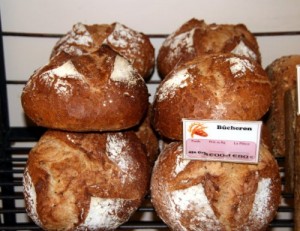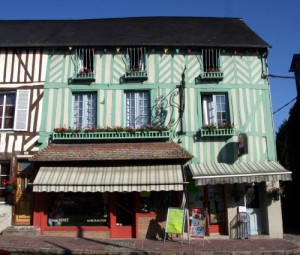 I fell in love with the Duchess of Windsor’s baker when I was 14. He was my penfriend’s uncle – a burly, jolly chap who showed me around his bakery in Boulogne Billancourt and sent me back to London with a freshly baked tart for my family’s tea. I fell in love with baking at the same time.
I fell in love with the Duchess of Windsor’s baker when I was 14. He was my penfriend’s uncle – a burly, jolly chap who showed me around his bakery in Boulogne Billancourt and sent me back to London with a freshly baked tart for my family’s tea. I fell in love with baking at the same time.
Living in France in the 70s, I tried in vain to find an adult course in bread and pastry making — you know, classic evening class stuff. It seemed that to become a baker I should have started at 13 at a technical school with training days in a bakery. There was no other way to learn how to bake professionally. Training at a later age can only be done if your family is in the trade or you are out of work.
I finally learnt to bake at La Panetterie Louis David in Honfleur, France. I struck a bargain with ‘Madame’ to work the season in the shop and in return she asked her chefs to train me in the ‘atelier’ (workshop).
After my season in the shop, where I learnt all the names of cakes and types of breads, the really arduous work began. I arrived at 11 pm for the first bread shift. Mr David’s bakery made 35 types of bread with a variety of pre-mixed flours. Nowadays it is fairly common to find such a variety.
French bread flour is very different from British flour which tends to be hard. Take a fistful of flour and squeeze it in your hands. If it keeps it shape when you open your fists, the flour is soft flour, considered by British bakers to be unfit for bread but good for cakes and pastry. In France this flour is known as ‘type 55’ and it is used for nearly everything. It has a low gluten content which means it will lose all its elasticity if handled roughly and the loaf will not rise. It is not for industrial bakers.
The whole world knows the distinctive shape of French bread and many people can remember the heady perfume of new baked bread wafting down village streets. Basic French breads are the 500 gram ‘Pain’(loaf), the 400gram loaf, the 250 gram ‘Baguette’(wand) or flute, the skinny 100 gram ‘Ficelle’ (piece of string) and the ‘Boule’ (round loaf). A
 All these are made with plain white flour, nowadays bleached and with an anti-staling agent added. French housewives used to buy their bread 3 times a day, not so much for love of fresh food but because the bread staled rapidly.
All these are made with plain white flour, nowadays bleached and with an anti-staling agent added. French housewives used to buy their bread 3 times a day, not so much for love of fresh food but because the bread staled rapidly.
French breads are also distinguished from each other by the way they are baked and their markings. A ‘Pain’ usually has five slashes across its top but the same bread baked with diamond shaped slashes across it is called a POLKA. Sometimes a black metal mould which takes six loaves side by side is used for baking. If you like really crusty bread, ask for ‘non-moule’. A pain de tradition sign outside a shop, indicates the baker makes old-fashioned bread with unbleached flour and bakes it on the floor of the oven as opposed to in a mould. Most bakers are equipped with modern ovens but there are still quite a few in France who bake in wood fired ovens (au feu de bois). Poilane in Paris is the best known.
Different types of flours are used to make specialist breads like the Pain de Campagne (Country loaf — usually a mix of rye and plain flour), Pain Complet (wholemeal flour), Pain de Seigle (rye flour), Pain Brie (white flour but heavily beaten and very dense — a Norman specialty), and Pain de Son (bran bread — a diet bread).
 Rye bread is traditionally eaten with salt butter and oysters and toasted to serve hot with pate. Pain Brie, because of its denseness keeps for a long time and was often taken to sea by fishermen. It is traditionally eaten with salt butter and shrimp.
Rye bread is traditionally eaten with salt butter and oysters and toasted to serve hot with pate. Pain Brie, because of its denseness keeps for a long time and was often taken to sea by fishermen. It is traditionally eaten with salt butter and shrimp.
Pain de Mie and Viennois are breakfast breads using fine flour, eggs and milk — what British bakers call ‘Morning Goods’. Pain d’Epice (gingerbread) is common for breakfast too. It should be honeyed and succulent but is often very dry. Don’t be satisfied with croissants or brioche from the supermarket. Ask your French friends where they buy. Housewives often buy bread from one baker and brioche, croissants and tarts from another.
Really good bakers often have a huge round country loaf which they decorate with bunches of grapes, tendrils and leaves like Poilane’s famous loaf. If, in addition, the bread is a sourdough (incorporating a handful of dough from last week), it will have a delicious taste and will keep for a week or more.
In David’s, the master Baker used to use old Pain Brie dough to mould all sorts of creatures which children adored — lobsters, doves, crabs, little apples, bunches of grapes.
 In different parts of France, other ingredients are added to the dough to produce olive bread in the south, apple bread in Normandy, walnut bread along the Loire. Taste the Hawaiian Bread with coconut and hazelnuts at Fauchon’s (think Harrod’s Food Hall) in the Place de la Madeleine in Paris.
In different parts of France, other ingredients are added to the dough to produce olive bread in the south, apple bread in Normandy, walnut bread along the Loire. Taste the Hawaiian Bread with coconut and hazelnuts at Fauchon’s (think Harrod’s Food Hall) in the Place de la Madeleine in Paris.
Petits Pains au Lait (small dinner rolls) are sold almost everywhere. In the Basque country, corn breads and pumpkin breads are eaten with afternoon tea. Pain de Gruau – finest Wheaten Bread is made all over France. Fougasses are a specialty of the South and Epis (Ears of Corn shaped bread) and Couronnes (crowns)are everywhere. These doughs are the same as an ordinary loaf but are moulded or cut to different shapes.
One of the best breads of France is le Pain de Beaucaire near Avignon. The dough is cut into two rectangles which are placed on top of each other and then cut into squares, left to rise and then baked on the side. In Gannat, there is a traditional bread made with cottage cheese (nowadays substituted with Gruyere) called Le Gateau de Gannat and a wonderful Pear Bread called Piquenchagne. Taste the Pompe aux Gratons, made with pork crackling (but not the skin!), eggs and butter.
 Every region has its specialities and although the recipe varies little, the quality of the flour, the number of risings and the competence of the baker all combine to give deliciously different results. Traditionally, the French used up stale bread and apart from breadcrumbs, made a variety of Panades or Bread soups. I have given Poilane’s recipe as well as two of my favourites for cold winter days.
Every region has its specialities and although the recipe varies little, the quality of the flour, the number of risings and the competence of the baker all combine to give deliciously different results. Traditionally, the French used up stale bread and apart from breadcrumbs, made a variety of Panades or Bread soups. I have given Poilane’s recipe as well as two of my favourites for cold winter days.
Recipes
La Panade de Poilane
Toast your stale bread and break into pieces.
Place in saucepan and cover with water and a pinch of salt.
Simmer for an hour till bread is soft.
Break up with a fork.
Add a big knob of butter and just before serving, a soupspoon of cream.
La Panade de Gisele Caumon
Place the stale bread broken into pieces in a saucepan.
Cover with chicken stock.
Cook until soft and break up with fork.
Add salt, freshly ground black pepper.
At the last minute, stir in two or three eggs and lightly cook.
Add a soupspoon of chopped parsley.
Serve with a knob of butter in each plate.
La Panade de Mme Chartier
Place your stale bread in a saucepan.
Cover with left over red wine.
Heat up till bread is soft.
Break up with fork.
This soup has no salt or pepper in cooking but is much improved with a pinch of nutmeg especially if your wine has a lot of tannin. Freshly ground black pepper can be added to taste.
Photo Credits
Photos © Julia McLean. All Rights Reserved.
This article was first published in The Connexion.


Please Share Your Thoughts - Leave A Comment!